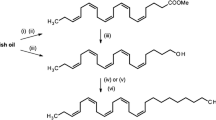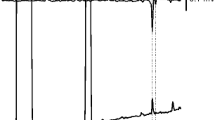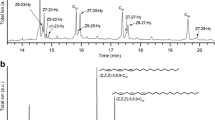Abstract
The non-polar components of female body wax and pheromone gland extracts of the yellow peach moth synergistically enhanced male behavioral responses from close to pheromone sources in wind tunnel tests when mixed with an aldehyde pheromone blend. When the non-polar fractions (NPFs) of female body wax were further separated by column chromatography, synergistic activities were found in the 3 and 50% ether in hexane fractions, and they additively increased male responses. The main components of the first fraction were (Z)-9-tricosene, (Z)-9-pentacosene, (Z)-9-heptacosene, (Z)-9-nonacosene and (Z)-9-hentriacontene. Only (Z)-9-heptacosene showed a significant synergistic effect in enhancing male responses, but the other components had no effect. A mixture of the five monoenyl hydrocarbons lost activity at lower doses than 5 ng. Natural ratios of these hydrocarbons in the female body wax and pheromone gland extracts were similar, but the amount of (Z)-9-heptacosene in the female body wax was significantly higher than in the pheromone gland extracts. We conclude that (Z)-9-heptacosene increases male responses to aldehyde pheromones, and unknown component(s) in the 50% ether in the hexane fraction are required for full synergistic enhancement by the NPFs of the female body wax and the pheromone gland extracts.


Similar content being viewed by others
References
Ando T, Inomata S, Yamamoto M (2004) Lepidopteran sex pheromone. Top Curr Chem 239:51–96
Böröczky K, Crook DJ, Jones TH, Kenny JC, Zylstra KE, Mastro VC, Tumlinson JH (2009) Monoalkenes as contact sex pheromone components of the woodwasp Sirex noctilio. J Chem Ecol 35:1202–1211
Cabrera A, Eiras AE, Gries G, Gries R, Urdaneta N, Mirás B, Badji C, Jaffe K (2001) Sex pheromone of tomato fruit borer, Neoleucinodes elegantalis. J Chem Ecol 27:2097–2107
Carroll KK (1961) Separation of lipid classes by chromatography on Florisil. J Lipid Res 2:135–141
Francis GW, Veland K (1987) Alkylthiolation for the determination of double-bond positions in linear alkenes. J Chromatogr A 219:379–384
Gibb AR, Pinese B, Tenakanai D, Kawi AP, Bunn B, Ramankutty P, Suckling DM (2007) (Z)-11-Hexadecenal and (3Z,6Z,9Z)-tricosatriene: sex pheromone components of the red banded mango caterpillar Deanolis sublimbalis. J Chem Ecol 33:579–589
Ginzel MD, Moreira JA, Ray AM, Millar JG, Hanks LM (2006) (Z)-9-Nonacosene—major component of the contact sex pheromone of the beetle Megacyllene caryae. J Chem Ecol 32:435–451
Hill AS, Roelofs WL (1981) Sex pheromone of the saltmarsh caterpillar moth, Estigmene acrea. J Chem Ecol 7:655–668
Hill AS, Kovalev BG, Nikolaeva LN, Roelofs WL (1982) Sex pheromone of the fall webworm moth, Hyphantria cunea. J Chem Ecol 8:383–396
Honda H, Kaneko J, Konno Y, Matsumoto Y (1979) A simple method for mass-rearing of the yellow peach moth, Dichocrocis punctiferalis Guenée (Lepidoptera: Pyralidae), on an artificial diet. Appl Entomol Zool 14:464–468
Kimura T (2002) Chemical ecology of sex pheromones in Conogethes sibling species. Doctoral Dissertation at University of Tsukuba (in Japanese)
Kondo A, Nagata K, Mochizuki F (2008) Geographical differences in pheromone trap performance in the yellow peach moth, Conogethes punctiferalis (Guenée) (Lepidoptera: Pyralidae) occurring in Japanese peach orchards. Jpn J Appl Entomol Zool Chugoku Branch 50:35–38
Konno Y, Arai K, Sekiguchi K, Matsumoto Y (1982) (E)-10-Hexadecenal, a sex pheromone component of the yellow peach moth, Dichocrocis punctiferalis Guenée (Lepidoptera: Pyralidae. Appl Entomol Zool 17:207–217
Leal WS, Parra-pedrazzoli AL, Kaissling KE, Morgan TI, Zalom FG, Pesak DJ, Dundulis EA, Burks CS, Higbee BS (2005) Unusual pheromone chemistry in the navel orangeworm: novel sex attractants and a behavioral antagonist. Naturwissenschaften 92:139–146
Mant J, Brandli C, Vereecken NJ, Schulz CM, Francke W, Schiestl FP (2005) Cuticular hydrocarbons as sex pheromone of the bee Colletes cunicularius and the key to its mimicry by the sexually deceptive orchid, Ophrys exaltata. J Chem Ecol 31:1765–1787
Mazor M, Dunkelblum E (1992) Role of sex pheromone components in behavioral reproductive isolation between Autographa gamma (L.) and either Trichoplusia ni (Hübner) or Chrysodeixis chalcites (Esp.) (Lepidoptera: Noctuidae: Plusiinae). J Chem Ecol 18:2373–2384
Millar JG, Grant GG, McElfresh JS, Strong W, Rudolph C, Stein JD, Moreira JA (2005) (3Z,6Z,9Z,12Z,15Z)-Pentacosapentaene, a key pheromone component of the fir coneworm moth, Dioryctria abietivorella. J Chem Ecol 31:1229–1234
Omura H, Honda K (2005) Chemical composition of volatile substances from adults of the swallowtail, Papilio polytes (Lepidoptera: Papilionidae). Appl Entomol Zool 40:421–427
Sekiguchi K (1974) Morphology, biology and control of the yellow peach moth, Dichocrocis punctiferalis Guenée (Lepidoptera: Pyralidae). Bull. Ibaraki Hort. Expt. Stn., Special Issue (in Japanese with English summery)
R Development Core Team (2009) R is a language and environment for statistical computing and graphics. R Foundation for Statistical Computing, Vienna, Austria. http://www.r-project.org/
Uebel EC, Sonnet PE, Bierl BA, Miller RW (1975) Sex pheromone of the stable fly: isolation and preliminary identification of compounds that induce mating strike behavior. J Chem Ecol 1:377–385
Waterhouse DF (1993) The major arthropod pests and weeds of agriculture in Southeast Asia: distribution, importance and origin. ACIAR Monograph No. 21, Canberra, Australia
Xiao W, Honda H (2010) Non-polar body waxes enhance sex pheromone activity in the yellow peach moth, Conogethes punctiferalis (Guenée) (Lepidoptera: Crambidae). Appl Entomol Zool 45:449–456
Zhang AJ, Oliver JE, Chauhan K, Zhao BG, Xia LQ, Xu ZC (2003) Evidence for contact sex recognition pheromone of the Asian longhorned beetle, Anoplophora glabripennis (Coleoptera: Cerambycidae). Naturwissenschaften 90:410–413
Acknowledgments
We thank Shin-Etsu Chemical Co., Ltd., for providing E10-16: Ald and Z10-16: Ald. We also would like to express our sincere thanks to Prof. DeMar Taylor for reading the manuscript.
Author information
Authors and Affiliations
Corresponding author
Rights and permissions
About this article
Cite this article
Xiao, W., Honda, H. & Matsuyama, S. Monoenyl hydrocarbons in female body wax of the yellow peach moth as synergists of aldehyde pheromone components. Appl Entomol Zool 46, 239–246 (2011). https://doi.org/10.1007/s13355-011-0035-0
Received:
Accepted:
Published:
Issue Date:
DOI: https://doi.org/10.1007/s13355-011-0035-0




